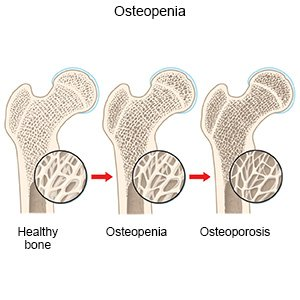Bones provide structure; without them, we couldn’t move. One condition affecting bones is osteopenia, a decrease in bone density. It’s gaining attention in India. This blog aims to remove myths, reveal lifestyle impacts, and highlight the importance of early detection of osteopenia. You might wonder if it’s similar to osteoporosis. Osteopenia is less severe but still deserves careful attention.
What is Osteopenia? Distinguishing From Osteoporosis
What is osteopenia? Simply put, it’s a condition where bones become weaker than normal, but not as brittle as in osteoporosis. Imagine a sponge. If it’s full, it’s heavy and dense. What causes osteopenia? Bone density loss begins, like the sponge drying out, making bones less dense. Many in India might not know they have it. In reality, osteopenia can slowly sneak up without a clue.
In the context of statistics, high numbers aren’t just numbers; each represent a person affected. India sees a rising prevalence of osteopenia. Lifestyle, sunshine exposure, and dietary habits also impact bone health. For instance, consuming enough calcium or getting sunlight helps keep bones strong. If you live in densely populated areas where lifestyle is fast-paced, dietary habits fluctuate more with Western influences, it’s something to monitor.
Culturally, since joint families are common in India, there might be more awareness about osteoporosis due to elders. But osteopenia can affect anyone, emphasizing the need for awareness across ages.
Identifying Symptoms and Risk Factors of Osteopenia
So, what causes osteopenia? Age, for starters, affects everyone. At what age does osteopenia start? Well, it doesn’t have a specific start, but risk increases post-30. After this age, bone mass naturally decreases.
Here are some risk factors:
- Aging: Can’t avoid, one major cause.
- Hormonal changes: Especially during menopause in women.
- Lifestyle: Lack of exercise or poor diet choices.
Common symptoms may not be evident immediately. Some might experience back pain or weaker grips as initial signs. Recognizing lesser-known symptoms like fractures from minor falls can be crucial. Early diagnosis through bone density tests could change health paths significantly.
Lifestyle plays a big role. Reduced physical activity or diets poor in calcium and vitamin D contribute. Smoking and excessive alcohol consumption don’t help either. Understanding what causes osteopenia can help in tackling it early on.
Integrating Treatment Options and Prevention Strategies
Osteopenia, while different from osteoporosis, needs attention. But what if you’re diagnosed with it? Or suspect you might be? What supplements help osteopenia and are there lifestyle changes you should consider?
- Lifestyle Changes:
- Diet: Eating foods rich in calcium like dairy or leafy vegetables supports bone health.
- Sun exposure: Natural sunlight helps in producing vitamin D, crucial for calcium absorption.
- Exercise: Regular physical activity supports bone strength. What is the best exercise for osteopenia? Weight-bearing exercises are beneficial, like walking or light jogging.
- Medical Treatments:
- Physician guidance can clarify what is the best medicine for osteopenia. Typically, bisphosphonates or supplements as prescribed.
- Hormonal treatments might aid especially if the cause is linked to menopause.
- Prevention Strategies:
- Ensuring a balanced diet from an early age is a lifetime investment.
- Regular check-ups after 30 can track bone density, addressing issues early.
Mixing traditional methods, with simple lifestyle tweaks, alongside modern medicine strengthens bones. Indian practices, like yoga, offer gentle bone-supportive exercises. Yoga not only builds strength but also enhances flexibility, which lessens fall risks. Ayurveda, a traditional Indian medicinal system, comes with herbal supplements theorized to aid in bone health.
What should I do if I have osteopenia? Knowledge is the first step. Understanding risk factors, getting regular check-ups, and adapting lifestyles help. Staying informed is empowering, preventing further bone weakening.
Ultimately, osteopenia, although less aggressive than osteoporosis, requires attention and action. Simple lifestyle adaptations, combined with medical advice and cultural wisdom, may lead to positive health outcomes. Ensuring bones stay strong means drawing the line between a vibrant lifestyle and possible fractures. Healthy bones stay strong, encouraging everyone to step forward every day confidently and assured.

